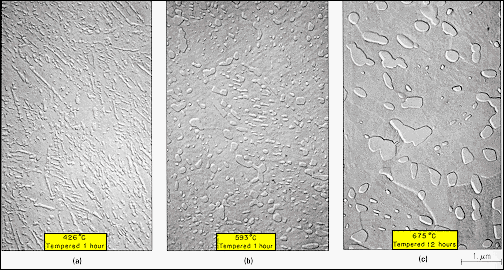| |
|
The micrographs
below show the effect of annealing at different temperatures on a
sample of Fe - 0.7 wt % C steel in which martensite has been formed by quenching.
Because of the low carbon content the martensite is relatively dispersed.
In this tempering process, martensite precipitates Fe3C in an
a-iron matrix and the micrographs show
how the cementite phase changes its shape to minimize its surface to volume
ratio. The ideal final morphology would be spherical cementite particles in
the matrix and this class of tempered martensite is known as spheroidite. They
have less elastic strain than martensite and the carbide phase is more dispersed
giving a more ductile material.
Pearlite and bainite can also have
their cementite morphology changed to this spheroidite structure by tempering,
but the process requires a longer time. |
|
| |
From:
Schafer, Saxena, Antolovich, Sanders and Warner, "The Science and Design
of Engineering Materials," McGraw Hill (1999) |
|
